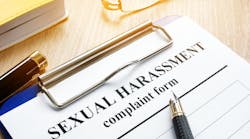Increasingly, employees are looking to their employers to handle workplace violence situations that can be considered safety risks, such as threats, altercations, sexual harassment, and others. And the legal system is willing to address these issues even if employers are not.
For example, in October 2022, a jury awarded $250,000 to a former Sam’s Club employee who alleged that the company fired her in retaliation for complaining about sexual harassment. The jury found that the employee had made the complaint to someone she believed had the authority to investigate her complaint, but she was fired for doing just that.
Incidents of this type are growing. Between 2018 and 2021, 98,411 charges were made alleging harassment under any basis, and 27,291 charges alleged sexual harassment, according to the U.S. Equal Employment Opportunity Commission (EEOC). Over the same period of time, the EEOC recovered almost $300 million for individuals making sexual harassment claims. In short, it’s more important than ever that companies learn to recognize, understand and mitigate risks of workplace threats and violence.
EHS Today talked with attorney Abby Warren, a partner with Robinson+Cole’s Labor, Employment Benefits and Immigration Group, about specific action-steps safety professionals can take to address these issues.EHS Today: Given your experience with setting up investigations into safety issues at work, can you provide some processes that companies can implement to evaluate an employee who is raising a harassment complaint around these issues?
Abby Warren: The first decision with a complaint is to determine if an investigation is necessary. Things to consider are the law around the issues and the policy that the company has created for itself. For example, even if there isn’t a particular legal obligation to investigate the complaint, the company may have decided that it is company policy to investigate these issues. It could be they are viewing the issues from a business, operations, or employee relations perspective.
The next step—once it’s been determined an investigation needs to be done—is to decide who is going to handle it. For larger companies, there might already be a department or even HR that handles these types of things. If you have a trained HR staff and the situation is not complicated, they might be able to handle it. For a smaller company, outside help might be necessary.
Another important factor in deciding between an internal or external investigation is the nature of the complaint. Is this a very specific case or is it systemic? Does the complaint involve the C-suite? In such a case it might be better to have a couple of different perspectives on the situation so both an internal and external investigation might be in order. And there is always the issue of optics, or how it would look to the employees, other stakeholders, or a judge or jury. Would an external person bring a level of credibility to the situation that might not be achieved internally?
EHS: Once a company decides to investigate the complaint, what are the next steps?
Warren: Some major decisions happen along the way, so I’ll explain the process.
Scope—A company shouldn’t conduct an open-ended investigation. It should be narrowly defined. For example, did sexual harassment occur between the employees and were these the statements made? When you sit down with a complainant the scope of the investigation might be changed but that change has to be intentional. If it changes everyone involved with this issue must understand exactly what is being looked into.
Privacy and Confidentiality—A decision must be made whether statements made to the investigator are covered under attorney-client privilege or will be maintained confidentially. There also has to be agreement, if confidentiality or privilege is waived, as to what information will be made public and who will get the information.
In general, the issue of confidentiality is interesting because the interpretation of the law that governs it—under the National Labor Relations Act—changes under different administrations. For example, the issue of whether an employer can require confidentiality during an investigation could be at issue. Currently, a company has the option to require employee confidentiality, but that could change.
Once an investigation is closed there is usually some type of communication made to both parties about the determination. It could be that the matter is now closed, or they can detail which allegations were substantiated and which were not.
Sometimes corrective or remedial action can be the result of an investigation. It could be changes in policy or training.
As far as communicating the result to the entire company, that would be a strategic decision.
Safety Considerations—What are the implications of the complaint, or issue, from a safety prospect? Does an internal measure need to be taken because of this complaint? Is someone at risk? Does something need to be done that might not impact the integrity of the investigation, but needs to happen for safety reasons? At the end of the day, you must have a safe workplace. Ensuring safety in the workplace is a legal obligation.
EHS: When rendering findings on a case, many investigators use the guiding principles of the Association of Workplace Investigators (AWI). Can you explain that?
Warren: Once we’ve made the decisions I talked about, we then interview witnesses, gather documents, ask for responses, and then render findings. When coming to a finding we use AWI’s guidelines, which are a set of principles at a high level. While every investigation is different, these guidelines provide a standard as to how to review and analyze the information using the same set of factors. For example, we don’t use a person’s demeanor in deciding the case, because people present themselves in different ways based on race, gender, culture, upbringing, etc.
EHS: What are some proactive steps that companies can take to help ensure that the workplace culture is such that complaints like these do not occur?
Warren: Over time companies have become more involved with interpersonal issues and so [they] view potential employees differently than in the past. Today, we see that many companies are checking references and engaging in other pre-employment screenings.
Once on board, reviewing conduct and behavior has become more important. To help prevent aggressive behavior in the workplace, companies are making sure that supervisors are very visible. The more they are on the floor, for example in a manufacturing plant, the more they know the behaviors of employees, and if something seems off, they can identify it.
Supervisors should be trained and expectations of workforce behavior should be set. One idea is to put that directly into performance reviews of supervisors.
To ensure a safe workplace for all, a company’s value statement should be instilled in specific policies.


